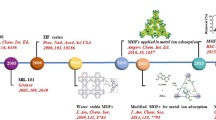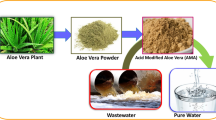Abstract
Heavy metals occur naturally but are released into the environment in large amounts by human activity, reaching dangerous concentrations. Both in aqueous media and soils, these can be found as dissolved cations. Adsorption was shown to be an effective mechanism to remove heavy metals presented in this form. Two new adsorbents, mercapto and amine-mercapto-functionalized silica xerogels (M and AM), have been synthesized using sol–gel chemistry to decontaminate the above mentioned polluted media. Their adsorption capacity has been tested in batch equilibrium and kinetic adsorption tests with single-cation aqueous solutions of copper and lead. It was found that both adsorbents remove the cations from solution but it is the amine-mercapto xerogel, the one with the highest uptake for the metals, reaching a capacity of 125 mg/g for Pb and 140 mg/g for Cu when the initial concentration of the cations is 500 ppm. Kinetic studies showed that the removal process is fast, with most of the cation being removed in the first 20 min of the process (60% for lead and 80% for Cu). The combination of equilibrium and kinetic results evinces that the adsorption of both copper and lead by mercapto and amine-mercapto xerogels happens predominantly as monolayer chemisorption.
Graphical Abstract





Similar content being viewed by others
References
Duffus JH (2002) “Heavy metals”— a meaningless term? Pure Appl Chem 74:793–807
Kirpichtchikova TA, Manceau A, Spadini L, Panfili F, Marcus MA, Jacquet T (2006) Speciation and solubility of heavy metals in contaminated soil using X-ray microfluorescence, EXAFS spectroscopy, chemical extraction, and thermodynamic modeling. Geochim Cosmochim Acta 70(9):2163–2190. doi:10.1016/j.gca.2006.02.006
Adriano DC, Wenzel WW, Vangronsveld J, Bolan NS (2004) Role of assisted natural remediation in environmental cleanup. Geoderma 122(2–4):121–142. doi:10.1016/j.geoderma.2004.01.003
Adriano DC (2001) Trace elements in terrestrial environments: biogeochemistry, bioavailability, and risks of metals, 2nd edn. Springer, New York
Kabata-Pendias A (2011) Trace elements in soils and plants, 4th edn. CRC Press, USA
Bolan NS, Adriano DC, Naidu R (2003) Role of phosphorus in (Im)mobilization and bioavailability of heavy metals in the soil-plant system. Rev Environ Contam Toxicol 177:1–44
Bolan NS, Choppala G, Kunhikrishnan A, Park J, Naidu R (2013) Microbial transformation of trace elements in soils in relation to bioavailability and remediation. In: Whitacre MD (ed) Reviews of environmental contamination and toxicology. Springer New York, NY, pp 1–56. doi:10.1007/978-1-4614-6470-9_1
Mahimairaja S, Bolan NS, Adriano DC, Robinson B (2005) Arsenic contamination and its risk management in complex environmental settings. Adv Agron 86:1–82. doi:10.1016/s0065-2113(05)86001-8
Young SD (2013) Chemistry of heavy metals and metalloids in soils. In: Alloway JB (ed) Heavy metals in soils: Trace metals and metalloids in soils and their bioavailability. Springer Netherlands, Dordrecht, pp 51–95. doi:10.1007/978-94-007-4470-7_3
Mico C, Peris M, Recatala L, Sanchez J (2007) Baseline values for heavy metals in agricultural soils in an European mediterranean region. Sci Total Environ 378(1–2):13–17. doi:10.1016/j.scitotenv.2007.01.010
Micó C, Peris M, Sánchez J, Recatalá L (2006) Heavy metal content of agricultural soils in a Mediterranean semiarid area: the Segura river valley (Alicante, Spain). Span J Agric Res 4:363–372
Soares HMVM, Boaventura RAR, Machado AASC, Esteves da Silva JCG (1999) Sediments as monitors of heavy metal contamination in the Ave river basin (Portugal): multivariate analysis of data. Environ Pollut 105:311–323
Oliveira A, Pampulha ME (2006) Effects of long-term heavy metal contamination on soil microbial characteristics. J Biosci Bioeng 102(3):157–161. doi:10.1263/jbb.102.157
Otero XL, Huerta-Diaz MA, Macı́as F (2000) Heavy metal geochemistry of saltmarsh soils from the Rı́a of Ortigueira (mafic and ultramafic areas, NW Iberian Peninsula). Environ Pollut 110(2):285–296. doi:10.1016/S0269-7491(99)00302-4
Guillén MT, Delgado J, Albanese S, Nieto JM, Lima A, De Vivo B (2012) Heavy metals fractionation and multivariate statistical techniques to evaluate the environmental risk in soils of Huelva township (SW Iberian Peninsula). J Geochem Explor 119, 120:32–43. doi:10.1016/j.gexplo.2012.06.009
Wuana RA, Okieimen FE (2011) Heavy metals in contaminated soils: a review of sources, chemistry, risks and best available strategies for remediation. ISRN Ecol 2011:1–20. doi:10.5402/2011/402647
Bolan N, Kunhikrishnan A, Thangarajan R, Kumpiene J, Park J, Makino T, Kirkham MB, Scheckel K (2014) Remediation of heavy metal(loid)s contaminated soils--to mobilize or to immobilize? J Hazard Mater 266:141–166. doi:10.1016/j.jhazmat.2013.12.018
Vareda JP, Valente AJ, Durães L (2016) Heavy metals in Iberian soils: removal by current adsorbents/amendments and prospective for aerogels. Adv Colloid Interface Sci 237:28–42. doi:10.1016/j.cis.2016.08.009
Gurav JL, Jung I-K, Park H-H, Kang ES, Nadargi DY (2010) Silica aerogel: synthesis and applications. J Nanomater 2010:1–11. doi:10.1155/2010/409310
Maleki H, Durães L, Portugal A (2014) An overview on silica aerogels synthesis and different mechanical reinforcing strategies. J Non-Cryst Solids 385:55–74. doi:10.1016/j.jnoncrysol.2013.10.017
Aegerter M, Leventis N, Koebel MM (eds) (2011) Aerogels Handbook (Advances in Sol-Gel Derived Materials and Technologies). Springer. doi:10.1007/978-1-4419-7589-8
Howard AG, Khdary NH (2004) Spectrofluorimetric determination of surface-bound thiol groups and its application to the analysis of thiol-modified silicas. Analyst 129(9):860–863. doi:10.1039/B407566H
Jung H-S, Moon D-S, Lee J-K (2012) Quantitative analysis and efficient surface modification of silica nanoparticles. J Nanomater 2012:8. doi:10.1155/2012/593471
Faghihian H, Nourmoradi H, Shokouhi M (2013) Removal of copper (II) and nickel (II) from aqueous media using silica aerogel modified with amino propyl triethoxysilane as an adsorbent: equilibrium, kinetic, and isotherms study. Desalination Water Treat 52(1–3):305–313. doi:10.1080/19443994.2013.785367
Lee JY, Chen CH, Cheng S, Li HY (2016) Adsorption of Pb(II) and Cu(II) metal ions on functionalized large-pore mesoporous silica. Int J Environ Sci Technol 13(1):65–76. doi:10.1007/s13762-015-0841-y
Reichenauer G, Scherer GW (2001) Nitrogen sorption in aerogels. J Non-Cryst Solids 285(1–3):167–174. doi:10.1016/S0022-3093(01)00449-5
Reichenauer G, Scherer GW (2001) Effects upon nitrogen sorption analysis in aerogels. J Colloid Interface Sci 236(2):385–386. doi:10.1006/jcis.2000.7419
Durães L, Ochoa M, Portugal A, Duarte N, Dias JP, Rocha N, Hernandez J (2010) Tailored silica based xerogels and aerogels for insulation in space environments. Adv Sci Technol 63:41–46. doi:10.4028/www.scientific.net/AST.63.41
Do DD (1998) Adsorption analysis: equilibria and kinetics. Imperial College Press, London
Freundlich HMF (1906) Over the adsorption in solution. J Phys Chem 57:385–471
Ho YS, Porter JF, McKay G (2002) Equilibrium isotherm studies for the sorption of divalent metal ions onto peat: copper, nickel and lead 1single component systems. Water Air Soil Pollut 141(1):1–33. doi:10.1023/a:1021304828010
Acknowledgements
Work developed under the project “AeroMCatch—Silica Aerogels for Remediation of Soils Contaminated with Heavy Metals” (Process No 141735), by João Vareda and University of Coimbra, funded by Calouste Gulbenkian Foundation (Portugal), through the “Programa de Estímulo à Investigação 2015”. The authors gratefully acknowledge the fruitful discussion with Prof. Artur Valente (Dept. of Chemistry of University of Coimbra) on the chemical interactions/reactions of the functional groups of the xerogels.
Author information
Authors and Affiliations
Corresponding author
Ethics declarations
Conflict of interest
The authors declare that they have no competing interest.
Rights and permissions
About this article
Cite this article
Vareda, J.P., Durães, L. Functionalized silica xerogels for adsorption of heavy metals from groundwater and soils. J Sol-Gel Sci Technol 84, 400–408 (2017). https://doi.org/10.1007/s10971-017-4326-y
Received:
Accepted:
Published:
Issue Date:
DOI: https://doi.org/10.1007/s10971-017-4326-y




